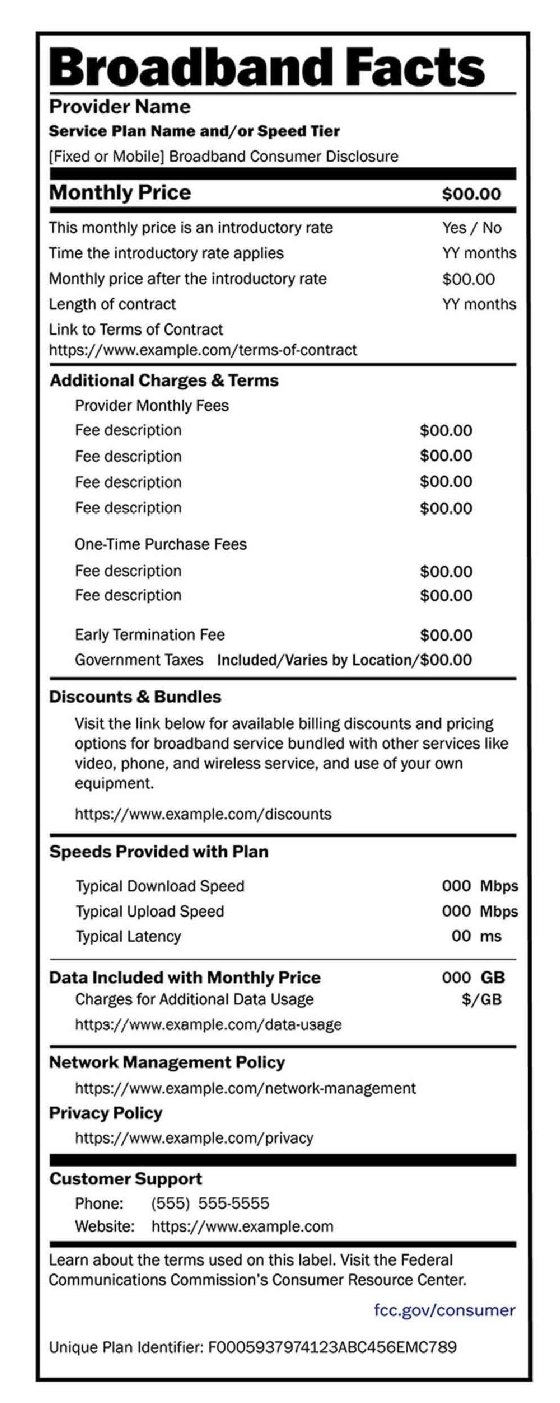
filo/DigitalVision Vectors via G
FCC broadband labels explained: Everything you need to know
Similar to how a nutrition label details food content, the FCC now mandates labels for internet providers to clarify service details for consumers to improve transparency.
How does one broadband service compare to another? How much actual bandwidth are consumers getting from a service, and what is the real cost? The answers to these and other fundamental questions about broadband service have not always been easy to understand or discover.
The U.S. Federal Communications Commission has been trying for years to help provide some clarity to broadband service for consumers. The FCC broadband labels debuted in 2024 to provide clarity for consumers.
The FCC broadband labels are similar to the nutrition labels used on food packaging in the U.S. Similar to nutrition labels that provide specific breakdowns of what's inside a food product, the broadband labels aim to offer clear information to consumers about what's being delivered by a broadband provider's service. The labels include important details about a broadband provider's service offerings, such as costs, speeds, data allowances and performance metrics.
The official deadline for implementation of the broadband labels for major internet service providers was April 10, 2024. For ISPs with less than 100,000 subscribers, the deadline is October 10, 2024.

Why did the FCC mandate broadband labels?
The FCC issued the broadband labels update for several reasons, but, most importantly, to encourage transparency to consumers.
"Consumer access to clear, easy-to-understand, and accurate information is central to a
well-functioning marketplace that encourages competition, innovation, low prices, and high-quality
services," the FCC order 22-86 states. "The same information empowers consumers to choose services that best meet their needs and match their budgets and ensures that they are not surprised by unexpected charges or service quality that falls short of their expectations."
The FCC mandated broadband labels to enhance transparency and empower consumers to make informed decisions when shopping for internet services. The initiative is part of a broader effort to improve consumer rights and access to information in the digital age.
The specific reasons for the FCC's mandate includes the following:
- Improved transparency. Consumers need to know exactly what is being offered in an easy-to-understand approach.
- Simplified provider comparisons. By standardizing the presentation of information, the labels make it easier for consumers to compare different broadband plans and providers.
- Increased provider accountability. The labels are intended to hold providers to their promises by clearly disclosing the terms of service, to prevent misleading advertising and to ensure that consumers get what they pay for and expect.
- Enhanced consumer protection. The labels are part of a broader initiative by the Biden administration to combat unfair pricing practices across the economy and protect consumers.
- Reinforced compliance with the Infrastructure Investment and Jobs Act (IIJA). The FCC mandate for the update to broadband labels was part of the IIJA, which aims to improve the country's infrastructure, including high-speed internet capacity.
What is included on the labels?
FCC broadband labels include information designed to make it easier for consumers to understand what is being offered.
Key elements included on an FCC broadband label are as follows:
- Broadband service provider name.
- Service plan name.
- Detailed pricing information, including the base monthly charge and any additional fees or charges such as introductory rates, contract terms and early termination fees, if applicable.
- Performance information including typical upload and download speeds and latency figures.
- Data allowances such as data caps or limits on data usage, including overage fees or consequences for exceeding these limits.
- Link to provider's network management policies.
- Privacy policy link detailing how customer data is handled.
- Disclosure of participation in FCC's Affordable Connectivity Program.
- Link to an FCC-provided glossary of technical terms.
Additionally, the labels need to be available in an accessible format. That format needs to comply with the Americans with Disabilities Act. Providers must consider alternate formats for people with visual impairments, such as Braille, large print materials or other effective techniques.
Providers are also required to make the information machine-readable format so other parties can gather and combine data for consumers to compare prices and plans.
Internet providers that need to have FCC broadband labels include both fixed and mobile internet service providers in the U.S. The requirement to display these labels applies to the majority of U.S. internet service providers.
History of FCC broadband labels
The history of the FCC broadband labels has evolved over several years, with key milestones marking the development and implementation of the initiative.
2009: The concept of a standardized broadband label was first proposed by New America's Open Technology Institute.
2010: The FCC issued its Open Internet Order, which included the first Transparency Rule for broadband providers. This rule required disclosure of information at the point of sale but did not mandate a specific format for this information.
2015: The FCC issued a second Open Internet Order, which required ISPs to disclose full monthly service charges, performance metric data and potential network practices affecting service. The order also planned for a uniform -- but voluntary -- disclosure format.
2016: The FCC released a broadband consumer label modeled on the nutrition facts label as a voluntary safe harbor for ISPs to satisfy transparency requirements.
2017: The FCC issued the Restoring Internet Freedom Order, which overturns the net neutrality rules from 2015 and discards the stricter transparency requirements, such as the optional broadband nutrition label.
2021: Representative Angie Craig introduces the Broadband Consumer Transparency Act of 2021 in March, directing the FCC to promote and incentivize widespread adoption of a standardized broadband label. In November, President Biden signed the IIJA, which includes a provision for the FCC to create updated broadband labels and regulations for ISPs on how to display these new labels.
2022: The FCC adopts rules requiring broadband providers to display broadband labels displaying key information.
2024: As of April 10, 2024, major ISPs with more than 100,000 subscribers were required to start displaying the labels. As of October 10, internet providers with 100,000 or fewer subscribers, are required to display the labels.
How will the FCC track compliance?
The FCC will track compliance for the broadband labels through several mechanisms including the following:
- Label archives. Broadband providers are required to maintain an archive of all broadband labels for two years after the service plan is no longer offered. This archive serves as a record of compliance and for the FCC to review.
- Evidence of accuracy. According to the FCC regulations, providers must maintain evidence sufficient to support the accuracy of the labels' content.
- Consumer complaints. If consumers report that they cannot find the labels or that the labels are inaccurate, the FCC can investigate.
- Audits and inspections. The FCC can conduct audits or inspections of providers to ensure that the labels are being displayed as required and contain accurate information.
The future of transparent pricing
The future of transparent pricing, particularly in the aftermath of the FCC broadband label rules, suggests a potential shift toward more widespread adoption of transparent pricing practices across various sectors.
The FCC's approach to broadband labels, as detailed in the "All-In Pricing for Cable and Satellite Television Service Report and Order," indicates a willingness to enforce transparency in pricing beyond broadband services. The principles applied to broadband could extend to cable services, where consumers also face challenges in understanding complex pricing structures, promotional rates and the true cost of service.
Sean Michael Kerner is an IT consultant, technology enthusiast and tinkerer. He has pulled Token Ring, configured NetWare and has been known to compile his own Linux kernel. He consults with industry and media organizations on technology issues.








